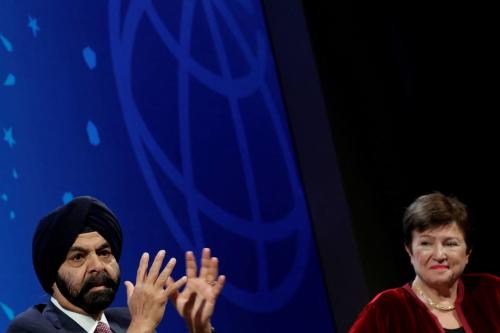Editor’s Note: Johannes Linn discusses the potential of multilateral development banks in the latest G-20 Research Group briefing book on the St. Petersburg G-20 Summit. Read the full collection here.
The origins of the multilateral
development banks (MDBs) lie
with the creation of the World
Bank at Bretton Woods in
1944. Its initial purpose, as the
International Bank for Reconstruction and
Development, was the reconstruction of wartorn countries after the Second World War.
As Europe and Japan recovered in the
1950s, the World Bank turned to providing
financial assistance to the developing world.
Then came the foundation of the InterAmerican Development Bank (IADB) in 1959,
of the African Development Bank (AfDB) in
1964 and of the Asian Development Bank
(ADB) in 1966, each to assist the development
of countries in their respective regions.
The European Bank for Reconstruction and
Development (EBRD) was set up in 1991,
following the collapse of the Soviet Union,
to assist with the transition of countries in
the former Soviet sphere.
The MDBs are thus rooted in two key
aspects of the geopolitical reality of the postwar 20th century: the Cold War between
capitalist ‘West’ and communist ‘East’, and
the division of the world into the industrial
‘North’ and the developing ‘South’. The former
aspect was mirrored in the MDBs for many
years by the absence of countries from the
Eastern Bloc. This was only remedied after
the fall of the Bamboo and Iron curtains. The
latter aspect remains deeply embedded even
today in the mandate, financing pattern and
governance structures of the MDBs.
Changing global financial architecture
From the 1950s to the 1990s, the international
financial architecture consisted of only
three pillars: the International Monetary
Fund (IMF) and the MDBs represented the
multilateral official pillar; the aid agencies
of the industrial countries represented bilateral official pillar; and the commercial
banks and investors from industrial countries
made up the private pillar.
Today, the picture is dramatically different.
Private commercial flows vastly exceed official
flows, except during global financial crises.
New channels of development assistance have
multiplied, as foundations and religious and
non-governmental organisations rival the
official assistance flows in size.
The multilateral assistance architecture,
previously dominated by the MDBs, is now a
maze of multilateral development agencies,
with a slew of sub-regional development
banks, some exceeding the traditional MDBs
in size. For example, the European Investment
Bank lends more than the World Bank, and
the Caja Andina de Fomento (CAF, the Latin
American Development Bank) more than
the IADB. There are also a number of large
‘vertical funds’ for specific purposes, such
as the International Fund for Agricultural
Development and the Global Fund to Fight
AIDS, Tuberculosis and Malaria. There are specialized trust funds, attached to MDBs, but
often with their own governance structures.
End of the North-South divide
Finally, the traditional North-South divide
is breaking down, as emerging markets have
started to close the development gap, as global
poverty has dropped and as many developing
countries have large domestic capacities.
This means that the new power houses in
the South need little financial and technical assistance and are now providing official financial and technical support to their less fortunate neighbors. China’s assistance to Africa outstrips that of the World Bank.
The future for MDBs
In this changed environment is there a future
for MDBs? Three options might be considered:
1. Do away with the MDBs as a relic of the
past. Some more radical market ideologues
might argue that, if there ever was a
justification for the MDBs, that time is now
well past. In 2000, a US congressional
commission recommended the less radical
solution of shifting the World Bank’s loan
business to the regional MDBs. Even if
shutting down MDBs were the right option, it
is highly unlikely to happen. No multilateral
financial institution created after the Second
World War has ever been closed. Indeed,
recently the Nordic Development Fund was
to be shut down, but its owners reversed their
decision and it will carry on, albeit with a
focus on climate change.
2. Carry on with business as usual. Currently,
MDBs are on a track that, if continued, would
mean a weakened mandate, loss of clients,
hollowed-out financial strength and diluted
technical capacity. Given their tight focus on
the fight against poverty, the MDBs will work
themselves out of a job as global poverty,
according to traditional metrics, is on a
dramatic downward trend.
Many middle-income country borrowers
are drifting away from the MDBs, since they
find other sources of finance and technical
advice more attractive. These include the
sub-regional development banks, which are
more nimble in disbursing their loans and
whose governance is not dominated by the
industrial countries. These countries, now
facing major long-term budget constraints,
will be unable to continue supporting the
growth of the MDBs’ capital base. But they
are also unwilling to let the emerging market
economies provide relatively more funding
and acquire a greater voice in these institutions.
Finally, while the MDBs retain professional
staff that represents a valuable global asset,
their technical strength relative to other sources
of advice – and by some measures, even their
absolute strength – has been waning.
If left unattended, this would mean that
MDBs 10 years from now, while still limping
along, are likely to have lost their ability
to provide effective financial and technical
services on a scale and with a quality that
matter globally or regionally.
3. Give the MDBs a new mandate, new
governance and new financing. If one starts
from the proposition that a globalised
21st-century world needs capable global
institutions that can provide long-term
finance to meet critical physical and social
infrastructure needs regionally and globally,
and that can serve as critical knowledge hubs
in an increasingly interconnected world,
then it would be folly to let the currently
still considerable institutional and financial
strengths of the MDBs wither away.
Globally and regionally, the world faces
infrastructure deficits, epidemic threats,
conflicts and natural disasters, financial
crises, environmental degradation and the
spectre of global climate change. It would
seem only natural to call on the MDBs,
which have retained their triple-A ratings and shown their ability to address these issues in the past, although on a scale that has been insufficient. Three steps would be taken under this option:
• The mandate of the MDBs should be
adapted to move beyond preoccupation
with poverty eradication to focus explicitly
on global and regional public goods as
a way to help sustain global economic
growth and human welfare. Moreover,
the MDBs should be able to provide
assistance to all their members, not only
developing country members.
• The governance of the MDBs should
be changed to give the South a voice
commensurate with the greater global role
it now plays in economic and political
terms. MDB leaders should be selected on
merit without consideration of nationality.
• The financing structure should be matched
to give more space to capital contributions
from the South and to significantly expand
the MDBs’ capital resources in the face of
the current severe capital constraints.
In addition, MDB management should be
guided by banks’ membership to streamline
their operational practices in line with those
widely used by sub-regional development
banks, and they should be supported in
preserving and, where possible, strengthening
their professional capacity so that they can
serve as international knowledge hubs.
A new MDB agenda for the G20
The G20 has taken on a vast development
agenda. This is fine, but it risks getting bogged
down in the minutiae of development policy
design and implementation that go far beyond
what global leaders can and should deal with. What is missing is a serious preoccupation
of the G20 with that issue on which it is
uniquely well equipped to lead: reform of the
global financial institutional architecture.
What better place than to start with
than the MDBs? The G20 should review the
trends, strengths and weaknesses of MDBs
in recent decades and endeavour to create
new mandates, governance and financing
structures that make them serve as effective
pillars of the global institutional system in the
21st century. If done correctly, this would
also mean no more need for new institutions,
such as the BRICS development bank
currently being created by Brazil, Russia,
India, China and South Africa. It would be
far better to fix the existing institutions than
to create new ones that mostly add to the
already overwhelming fragmentation of the
global institutional system.



Commentary
Realizing the Potential of the Multilateral Development Banks
September 5, 2013